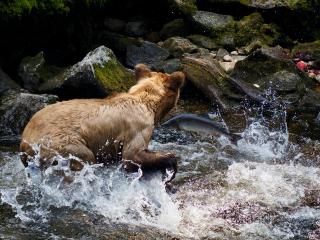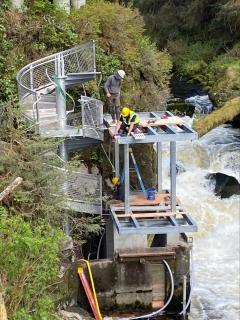Seeing eye to eye with Alaskan bears

ALASKA — A new viewing platform with a spiral staircase means visitors to the Anan Wildlife Observatory near Wrangell, Alaska, now have three vantage points for watching wildlife during the annual pink salmon run. Sitting on the Tongas National Forest, visitors can see eye to eye with both brown and black bears from the viewing platform, as they gather in large numbers to feed on fish in Anan Creek.
In-Field Manager Jen Kardiak explained that the idea for the unique structure was born when former Anan Manager Dee Galla discussed replacing the old platform and stairs. “She was standing on the upper deck and said, offhand, ‘Wouldn’t it be cool if we could just put the stairs straight down, like in a spiral or something?’”
The older wooden observation structure had begun to decompose in the temperate rainforest that characterizes the Tongass National Forest. When Great American Outdoors Act funding became available in 2020, Anan staff jumped at the opportunity to realize the vision for the new platform, spiral staircase and all.
Bringing the vision to life would hinge on collaborating with local companies whose specializations range from guiding visitors to building sophisticated structures in wild and remote locations.
The observatory, located 35 miles south of Wrangell, is only accessible by boat or float plane. Most visitors arrive through a permitted outfitter and guide service, and these guides were critical to the public comment process that informed the new deck design.
Wrangell District Ranger Tory Houser was a part of the team that oversaw that process. “The Forest Service really listened to the guide companies, because we trust them to give good input,” he said. “They bring in the majority of visitors, so we wanted to make sure that it would be usable for both them and their clients.”
Brenda Schwartz Yeager, a local guide and artist, provided an initial drawing of the concept. The Forest Service and contract design team then used this drawing as a basis for collaboration and the ultimate final design.
Once the design was selected, it was up to contractor Jesse West to determine how to best install the complicated infrastructure on the rocky banks of Anan Creek. He would have to figure out how to use a helicopter, so that he could complete a job that would have been better suited for a crane, had the location not been so remote.
After receiving the contract West spent months thinking through the logistics. All of the ways to get the staircase in. Every way it might go wrong. and all of the ways that he could possibly mitigate them. West explained that the success of the job would ultimately hinge on the synchronized timing of many factors. “As a remote site, it had the potential for things to go wrong, even with the best planning,” he said. “The barge and helicopter schedules, and the weather, all had to work.”
For days in advance, West prepared the rock foundation to ensure that the stairs would fit perfectly. When the big day came, “They had to fly it in by helicopter in two parts, match up the second part, and then use a sort of giant wrench to turn it into place,” noted Kardiak.
Once it was secured on the ground, there were other occupational considerations of working on a spiral staircase. And in this case the construction workers putting on the finishing touches got very dizzy, from repeatedly going up and down the stairs.
But there was important work to do, and after the floors and railings of the viewing platform were in place, staff needed to find a way to keep visitors from alerting the bears to their presence.
“Bears are disturbed by movement and sounds, and we don't want to scare the bears away that people are there to see,” explained Kardiak. Covering the staircase to make it “blind” to the bears proved challenging—especially given its spiral dimensions.
The Anan team eventually overcame this hurdle by using opaque screening with viewing windows cut into it. Kardiak noted that the blind also serves as a visual cue—subtly reminding visitors to keep their voices quiet when inside—to ensure the bears stick around longer. And to keep the sound down even further, West and his crew also applied a soundproof rubber coating to the metal stairs to muffle footsteps.
The three primary goals for the management of Anan Wildlife Observatory are to have as little effect on the bear populations as possible, to maintain the safety of bears and the public, and provide an extraordinary experience for visitors.
With the new multi-level viewing platform, visitors can now be at eye level with bears that are actively fishing, as well as those bears who are waiting in the wings for the prime fishing spots to become available. All without encountering the bears or disturbing their natural behaviors.
And thanks to the spiral staircase and new viewing platform the experiences have become that much more extraordinary, for both bears and visitors.



